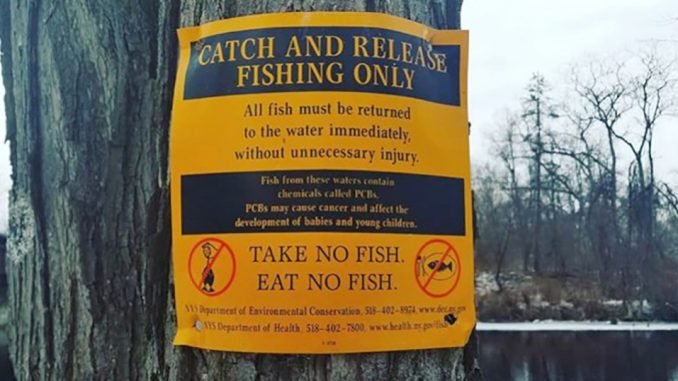
Cancer-causing man-made chemicals have been in the Hudson River for a long time, but a new report done by Scenic Hudson found that it will take an estimated $11.4 billion to clean up. General Electric (GE), a major American corporation, contaminated the 200-mile long river by dumping an estimated amount of 1.3 million pounds of polychlorinated biphenyl (PCBs) between the years 1947 and 1977 from its plant at Ft. Edwards.
PCBs are organic chlorine compounds that are classified as persistent organic pollutants. The US Congress banned PCB production in 1979 due to its environmental toxicity.
Dr. David Carpenter, the Director of the University of Albany’s School of Public Health, who describes the river as “a most beautiful hazardous waste site,” has studied the effects of PCBs on people’s health in Hudson Valley and found that cancer rates are higher here because of GE’s pollution of PCBs.
Some of the $11.4 billion includes damages to recreational fishing at $2.4 billion, damages to drinking water at $1.4 billion and damages to wildlife at nearly $6.4 billion, among other costs.
Between 2009 and 2015, GE spent $1.7 billion on a federally ordered multi-year dredging project, the largest environmental cleanup project ever undertaken. Dredging is the removal of sediments and debris from water bodies. This cleanup covered the 40-mile stretch of the upper Hudson, in which contaminated sediments were removed.
The cleanup of the river to remove PCBs was ordered in 2002 by U.S. Environmental Protection Agency after decades of objections from GE and upwards of $80 million spent by the corporation trying to avoid it.
While dredging may be necessary in this case to remove pollution, it also came at a cost to the environment. A 2021 report by the Hudson River Natural Resource Trustees found that the dredging harmed the environment by destroying wetlands and removing other natural resources like aquatic vegetation, freshwater mussels and shoreline trees. Despite the dredging project requiring GE to replace or restore damaged river habitats, the report found that many wetlands and aquatic vegetation beds are not recovering. New York State also contended that GE did not finish the cleanup of the river, while the corporation proclaimed their efforts as “one of the largest and most successful environmental cleanup projects ever undertaken in the United States,” and wrote on their website “Cleanup Meeting Goals, No More Dredging Needed.”
Former Gov. Andrew Cuomo was silent when GE announced it was pulling out from the cleanup; he tried to sway the corporation’s headquarters to move from Connecticut to Westchester County at the time. Local environmental groups like Scenic Hudson and Sierra Club were upset with GE’s pullout and led efforts to force GE to complete the dredging of the Hudson.
Scenic Hudson’s report concluded that additional dredging is necessary to rid the Hudson River of additional-PCB contaminated river sediments that will continue to harm wildlife creatures and communities by the river if not removed. The dredging would further reduce PCB concentration in Hudson River fish, making them safe for consumption and reducing the risk PCBs pose to natural resources.
GE has a long history of reparations for contaminating the Hudson River.
In 1976, the corporation agreed to pay $4 million toward a settlement of a case brought against them by the New York State’s Department of Environmental Conservation, which argued that the company violated water‐quality standards by dumping hundreds of thousands of pounds of PCBs into the upper Hudson.
Scenic Hudson has called for further damage assessments to be conducted on a federal and state level to recommend future restoration assessments.
“GE’s contamination has caused 70 years of harm that is expected to last another 50 years or more into the future,” said Dagmar Schmidt Etkin, one of the report’s authors.
Ned Sullivan, President of Scenic Hudson, voiced some optimism about the current state of the Hudson River, but explained further work must be done by GE. “While the current state of the Hudson is unacceptable there is reason for hope,” Huson said. “Under the EPA-mandated cleanup, G.E. has dredged an area of roughly 500 acres; removed 2.76 million cubic yards of PCBs and 310,000 pounds of contaminants. This compares to the original estimated removal of 490 acres, 2.65 cubic yards and 150,000 pounds of contaminants. The Hudson River is better off today than it was six years ago, when the cleanup began.”
“But an additional two years of dredging and cleanup of a couple of hundred acres of contaminated sediment would bring the river to a state of readiness for long term healing,” Hudson said.
“We are so close: Just two more years in a thirty-year struggle for a clean Hudson.”

